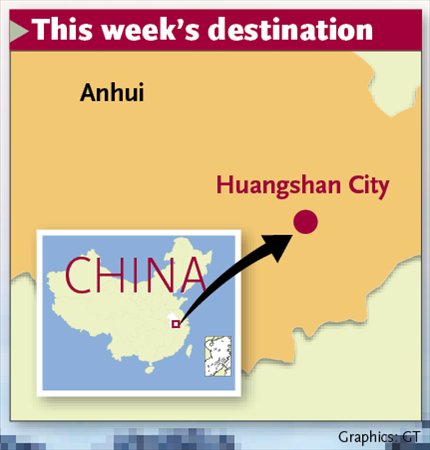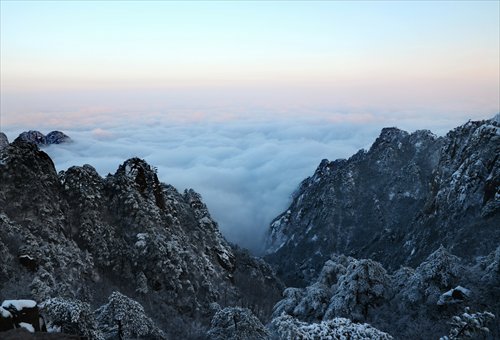Anhui charms

This week's destination

Huangshan Photo: CFP

Hongcun village Photo: CFP
The otherworldly beauty of Anhui's Huangshan has long captivated travelers, poets and painters. I had long wanted to visit, so right before Spring Festival, I made a last-minute decision to go.
Besides Huangshan, I would visit the villages of Xidi and Hongcun, considered among the most beautiful and best preserved in China. Just search for images online or watch Crouching Tiger, Hidden Dragon.
In the end, Huangshan and the villages did not disappoint. To top it all off, I was able to enjoy the company of thousands of happy, spirited fellow Chinese travelers.
Huangshan
Huangshan Mountain is probably the most famous in China. It's not that tall, reaching 1,864 meters at its highest, but it is immensely beautiful, renowned for its jagged slopes, uniquely shaped rocks, pine trees and the "sea of clouds" that can be seen from the mountain.
This has made it the subject of traditional Chinese landscape paintings and poems. It's also led to Huangshan becoming a UNESCO World Heritage Site. The villages of Xidi and Hongcun are also jointly a World Heritage Site.
To get to Huangshan, I went to the town of Tunxi via a six-hour overnight train journey from Nanjing. I took a bus to Tangkou, a small town at the foot of Huangshan's southern entrance, and stayed overnight in order to get an early start on the mountain. From Tunxi, I went to Xidi and Hongcun on different days.
On the day I went to Tangkou, it was clear and sunny, and Huangshan was a magnificent sight from the ground. I got a room and the next day, I woke up early and got to the shuttle bus stop at 6 am for the shuttle to the mountain entrance. That wasn't early enough as I was greeted by a huge mass of people. Hundreds of tourists, mostly cap-wearing members of tour groups, were all lining up.
The "line" extended past the steel barrier, with the narrow entrance a chokepoint. I've been in many crowds in China, but believe me, that was the closest I've ever come to being concerned about being crushed. At times things got rowdy, and parents with children would shout out pleas to those around them to stop.
I planned to take the cable car. Instead I ended up hiking to the top since the line for the cable car was horrendous, albeit impressive. The pathway consisted of thousands of stone steps and was challenging at times, but it was made easier by the fine views, both of the mountain looming above and of the clouds below. Along the way, I passed the "immortal pointing the way," a towering standalone rock on which a few pines grew.
Three hours later, I reached the top: White Goose Ridge, which ended at the Yungu upper cable car station. I settled on going to Bright Summit (1,840 meters), passing through pine forest, frozen wells and paths with a sweeping view of mist below, one of several cloud "seas." It seemed like each vantage point or object had a name: Welcoming-guest Pine, Jade Screen Peak, Flyover Stone and so forth.
Bright Summit proved a busy crossroads featuring a dome-topped meteorological station and hotel, and offering great view of an opposite peak where there was a pond. The summit swarmed with folks causing a lively commotion that easily made one feel as if this was a busy village, as opposed to the top of one of China's most beautiful mountains.
Remember the introduction to this article, specifically the part about enjoying being with thousands of happy travelers? I was being sarcastic. The whole time I was on Huangshan, I almost felt as I was in a competition with tour groups. Believe me when I say that I've learned my lesson about traveling to famous places at the same time as many thousands.
I wanted to circle around the top and take the other cable car down, but along the way the path was becoming increasingly congested and I backtracked once it was clear I couldn't make it through in time.
I took the Yungu cable car back down, descending into gray mist 1,600+ meters above the ground. I missed out on a lot of sights at Huangshan, but what I did see convinced me the mountain is deserving of its reputation.
Hongcun and Xidi
The villages of Hongcun and Xidi are both located in Yixian county, a little over an hour from Tunxi. The two villages have a history of over 900 years, featuring large, elegant houses built by wealthy merchants and prominent civil servants.
The villages are impressive reminders of a more illustrious past for this part of Anhui, formerly known as Huizhou, whose merchants used to dominate regional trade during the Ming (1368-1644) and Qing (1644-1911) dynasties. Nowadays prosperity has given way to a more sedate, but still beautiful charm.
In this region, the rural landscape is attractive also, featuring hills carpeted with tall swaying bamboo and villages with multistory homes topped with straight roofs with curved tiles and arched edges.
Xidi's most distinctive feature is a giant arch near its entrance, adjacent to a large pond at its side. With over 900 years of history, Xidi consists of main lanes, with alleys in between, filled with old houses that have weathered the test of time quite well. The houses mostly have weatherworn white exteriors and traditional-style tiled roofs with black, arched edges. Vendors sold Xuecaibing or preserved vegetable pastry, calligraphy brushes and carved wooden objects.
Besides wandering the lanes and admiring the old homes, you can enter large old multistoried wooden homes and clan halls such as Dujing Hall and Jing'ai Hall, which features a large open-air courtyard. Built by wealthy and distinguished men mostly during the Ming and Qing dynasties, the buildings feature large central halls framed by massive wooden pillars and beams. The houses also have high roofs with a rectangular opening for sunlight and air.
Where Xidi was elegant, Hongcun was beautiful. Founded in 1131, Hongcun is fronted by a small lake crossed by arched bridges that provide a fantastic sight enhanced by the reflection of the ancient houses in the water.
Like Xidi, there are several large houses built by wealthy families including Lexu, Chengzi and Jingxiu halls. These feature wooden interiors supported by ornately carved beams and columns. Chengzi Hall is particularly large, with multiple rooms left in a well-preserved state, like a museum.
A network of small open drains run through the lanes of Hongcun, conveying water from a nearby stream.
One of the most attractive sights within Hongcun is Yuezhao Moon Pond where I think one of the scenes from Crouching Tiger, Hidden Dragon was shot.
Hongcun is bigger than Xidi and features more buildings and sights, so try to allocate more time.
Despite the tourists, the two villages still retained a certain charm. Hongcun and Xidi were still places where people still live. The places weren't overrun with vendors and the vendors weren't persistent or obnoxious, as some in other tourist attractions are wont to be.
Near Yuezhao was an outdoor market where vendors sold duck, fish and even pork, split open and splayed to be hung out to dry. It definitely wasn't for tourists.
Hongcun is supposedly shaped like a cow: A hill at the west end is the head, the village is the body, Yuezhao is the stomach and the bridges are the legs. Unfortunately, I didn't have time for the whole village. I had to rush to get back to Tunxi and catch a train.
One last attraction
Finally there's one more attraction. It may be less famous than Huangshan and Hongcun, but it's also quite historic and beautiful: Tunxi's Ancient Street. Now a lot of towns across China have "ancient streets," but Tunxi's is genuinely old dating back to the Song Dynasty (960-1276) and the buildings are in amazing shape. No doubt there's been renovation, but the overall design and architecture remain intact.
I expected a small lane but I encountered a street packed with old stores that never seemed to end despite walking for almost an hour. The wooden buildings even brought to mind Kyoto in Japan. There were many restaurants and stores. Most interesting were bookstores that sold notebooks featuring covers with vintage Mao and '60s-era Communist art and quotations.
By the end, I was tired but extremely gratified. I'd like to think though Huangshan hasn't seen the last of me yet.
Rules of thumb
How to go: Tunxi is the nearest big town. Get there by direct flights from Beijing, Guangzhou, Shanghai and other major Chinese mainland cities. By train from Nanjing or Hefei; By long-distance bus from Nanjing, Hangzhou and Hefei. From Tunxi, you can take buses to Huangshan, Xidi and Hongcun.
When to go: Huangshan and the villages can be visited all year round. To see the "sea of clouds" on Huangshan, it's best to go between September and May.
Fares to enter Huangshan and take the cable car are cheaper from December to the end of February (non-peak season).